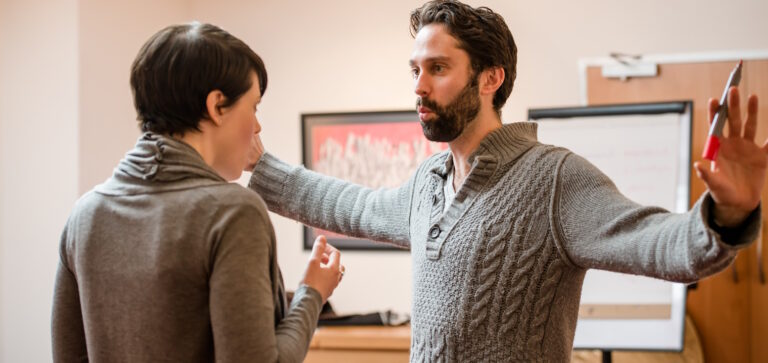
How to Prepare for a Presentation: 10 Essential Tips
Effective preparation is an important part of your presentation skills that goes way beyond memorising your slides.
How to Prepare for a Presentation: 10 Tips for Success
Want to know how to prepare for a presentation?
Effective preparation is an important part of your presentation skills that goes way beyond memorising your slides. You need to get to know your audience, structure your talk strategically, and rehearse the delivery. Do those key things right, and your presentations will inspire and motivate – not just inform.
Implement our tips for planning and practice, and you’ll be able to craft talks that achieve your objectives. Your listeners will walk away impressed and ready to take action.
In this article, we’ll break down the steps to set you up to prepare memorable presentations that get real results. You’ll learn how to be intentional with every phase of preparation. That’s the key to mastering this essential skill that boosts your professional impact.
- Know Your Audience
- Define Your Objectives
- Structure Your Presentation
- Create Effective Visual Aids
- Practice and Rehearse
- Incorporate Technology
- Manage Presentation Anxiety
- Engage Your Audience
- Handle Q&A Sessions
- Reflect and Improve
Key Takeaways
- Thorough preparation is crucial: Know your audience, define clear objectives, and structure your content logically.
- Practice makes perfect: Rehearse your delivery, manage anxiety, and be ready to handle Q&A sessions confidently.
- Engage your audience: Use effective visual aids, incorporate technology wisely, and interact with your listeners throughout your presentation.
- Continuous improvement is key: Reflect on each presentation, seek feedback, and consistently work on refining your skills.
How to Prepare for a Presentation
Know Your Audience
Before you start creating your presentation, take time to get to know your audience. This critical step allows you to shape your message to connect and engage them.
Look at key factors like:
- Demographics: their age range, professional backgrounds, industry experience
- Knowledge level: how familiar are they with your topic? Beginners or experts?
- Expectations: what are they hoping to get out of your talk?
For example, preparing a presentation on market trends to senior executives would look totally different than one for entry-level hires.
By analysing your audience makeup, you can adjust your content, terminology, examples, and tone to align with their needs and interests.
Define Your Objectives
Every standout presentation starts with clearly defining your objectives. These act like a compass, guiding your content and delivery.
Before crafting your talk, ask yourself:
- What’s the main purpose and goal of this presentation?
- What are the key points or insights I absolutely want the audience to take away?
- What action do I want people to take after my talk?
For example, if you’re pitching a new project proposal, your objective may be to secure approval and funding from your audience. This clear goal will help you focus on making the most compelling case with data and arguments.
You should also consider your call to action – the specific steps you want your audience to take post-presentation. Whether it’s implementing a strategy or approving a budget, a clear call to action provides a strong, purposeful close.
Structure Your Presentation
Preparing a well-structured presentation is key to guiding your audience through your ideas in a logical flow that keeps them engaged.
Think of your talk as a compelling story with a clear beginning, middle, and end. Start by outlining:
- Introduction: Grab their attention and set expectations
- Main body: Present your key points in a logical order that flows
- Conclusion: When ending your presentation, summarise and drive home your core message
Make sure each point naturally transitions into the next. This coherence helps your listeners follow your reasoning and retain information.
Also, budget time for each section. You want a balanced talk that covers all the crucial points without rushing or running long.
Create Effective Visual Aids
Visual aids can boost your message when used effectively. They should complement your words, not overshadow them.
Keep these key principles in mind:
- Simplicity rules: Use clean, uncluttered slide designs. Avoid overload.
- One main point per slide: Don’t cram it with too much info.
- Use high-quality, relevant images: Reinforce your message visually.
Remember, your slides are not your speaking script. Use them to highlight key points, data, or ideas that support what you’re saying. Illustrate complex concepts visually. Present data cleanly in charts or graphs.
The goal is to enhance your talk, not duplicate it. Craft visuals that work with your narrative, not against it. Follow these guidelines for slides that engage rather than distract your audience.
Practice and Rehearse
Rehearsing is critical for a polished, confident presentation. It lets you refine your content, timing, and delivery approach.
Effective practice techniques include:
- Rehearsing out loud: Get comfortable with your material by practicing aloud.
- Recording yourself: Watch or listen back to spot areas to improve.
- Getting feedback: Do a test run for friends or colleagues and ask for constructive critiques.
Pay attention to pace, tone, and body language. Are you speaking clearly and at a good speed? Do you convey confidence and enthusiasm through your body language?
Regular practice also helps you internalise your content, reducing reliance on notes. This allows for a smooth, natural delivery that engages your audience.
Don’t wing it – put in the preparation work. Thorough rehearsal is what takes your presentation from good to great. It ensures you deliver your message powerfully and professionally.
Incorporate Technology
Leveraging technology can enhance your presentation and demonstrate your adaptability in the digital age. However, it’s crucial to use it purposefully, not just for the sake of appearing tech-savvy.
Consider these technological tools:
- Advanced presentation software: Explore features in PowerPoint, Prezi, or Google Slides that can make your content more dynamic
- Interactive elements: Polls, Q&A platforms, or live word clouds can boost audience engagement
- Data visualisation tools: Use these to present complex information in an easily digestible format
While technology can elevate your presentation, always have a backup plan. Technical glitches can happen, so be prepared to deliver your key points without relying entirely on your visual aids.
Manage Presentation Anxiety
Even seasoned professionals can experience nervousness before a presentation. The key is to manage this anxiety effectively, channelling it into positive energy.
Try these techniques to calm your nerves:
- Deep breathing exercises: Practice controlled breathing to reduce stress
- Positive visualisation: Imagine yourself delivering a successful presentation
- Power posing: Adopt confident body language as you prepare for your presentation to boost your self-assurance
Remember, some level of nervousness is normal and can even enhance your performance. It shows you care about delivering value to your audience. Focus on your message and the benefits you’re providing to your listeners rather than on your own discomfort.
Engage Your Audience
An engaged audience is more likely to retain information and act on your message. Interaction shouldn’t be limited to the Q&A session at the end.
Consider these engagement strategies:
- Ask thought-provoking questions: Encourage your audience to reflect on your points
- Use storytelling: Illustrate key concepts with relevant anecdotes or case studies
- Incorporate movement: Use your body language and physical space dynamically to maintain visual interest
Tailor your engagement techniques to your audience and the formality of the setting. A workshop might allow for more interactive elements than a board meeting, for instance. The goal is to create a connection with your audience that goes beyond merely presenting information.
Handle Q&A Sessions
Question and answer sessions can be challenging, but they’re also an opportunity to showcase your expertise and reinforce your key messages.
Prepare for Q&As by:
- Anticipating potential questions: Think about what your audience might ask and prepare concise answers
- Listening carefully: Make sure you understand the question before responding
- Being honest: If you don’t know an answer, say so and offer to follow up later
Remember, it’s okay to take a moment to gather your thoughts before responding. This pause can help you provide more thoughtful, valuable answers.
Reflect and Improve
Continuous improvement is key to developing strong presentation skills. After each presentation, take time to reflect on your performance.
Consider these questions:
- What went well?
- What could I improve next time?
- Did I achieve my objectives?
If possible, ask for feedback from colleagues or audience members. Their perspectives can provide valuable insights you might have missed.
Use this reflection to set specific goals for your next presentation. Maybe you want to improve your slide design, or perhaps you’d like to incorporate more interactive elements. Each presentation is an opportunity to refine your skills.
How Impact Factory Can Help
At Impact Factory, we specialise in helping professionals like you take their presentation skills to the next level. Our tailored training programs address every aspect of effective presenting, from preparation to delivery.
We offer:
- Storytelling for Business Training: Learn to captivate your audience with compelling narratives
- Public Speaking Training: Develop confidence and presence in front of any audience
- Pitching for Business Training: Master the art of persuasive presentations
Our experienced trainers use practical, hands-on methods to help you discover and enhance your unique presentation style. We don’t believe in a one-size-fits-all approach; instead, we work with you to build on your strengths and address your specific challenges.
Ready to transform your presentation skills? Contact us at +44 (0)20 7226 1877 or enquiries@impactfactory.com to learn more about our programs.
Remember, every great presenter started somewhere. With the right guidance and practice, you can become the confident, impactful presenter you aspire to be.
FAQs
What is the 5 5 5 rule for better presentation?
The 5 5 5 rule is a simple guideline to create more effective slides. It suggests:
- No more than 5 words per line of text
- No more than 5 lines of text per slide
- No more than 5 text-heavy slides in a row
This rule helps keep your slides concise and your audience engaged. Remember, your slides should support your speech, not be a script for you to read from.
What are the 5 main things to be considered before giving a presentation?
The five key considerations are:
- Know your audience: Understand their needs and expectations
- Define your objectives: Be clear about what you want to achieve
- Structure your content: Organise your ideas logically
- Prepare your visual aids: Create effective, supportive slides
- Practice your delivery: Rehearse to build confidence and refine your timing
Focusing on these areas will help you create and deliver a more impactful presentation.
What are the 7 C’s of presentation?
The 7 C’s provide a comprehensive framework for effective presentations:
- Clear: Your message should be easily understood
- Concise: Keep your content focused and to the point
- Concrete: Use specific examples and data to support your ideas
- Correct: Ensure all information is accurate and up-to-date
- Coherent: Your points should flow logically from one to the next
- Complete: Cover all necessary information to achieve your objectives
- Courteous: Show respect for your audience’s time and attention
Applying these principles will help you create presentations that are both informative and engaging.
What should I do 10 minutes before a presentation?
In the final moments before your presentation:
- Review your opening and closing statements
- Take deep breaths to calm any nerves
- Ensure your technology is working correctly
- Have a glass of water ready
- Use the restroom if needed
- Adopt a confident posture to boost your mindset
These last-minute preparations can help you start your presentation feeling focused and confident.
Related Articles:
Now you know how to prepare for your presentation. But how can you take your skills another step further?
- Presentation Skills Course London UK – Boost your Confidence – Sign up for our Presentation Skills course.
- The Reason Why Your Workplace Presentation Skills Are So Important – Learn about the importance of presentation skills for your career.
- What Makes a Bad Presentation: Top 9 Mistakes to Avoid – Avoid the most common presentation mistakes.








